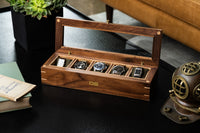
Brothers Jean and Charles Henri Stern - (Image by Patek Philippe)
1932 was an important year for Patek Philippe. In the midst of the Great Depression, Jean and Charles Henri Stern, owners of a successful dial factory in Geneva, invested in the company. The two brothers immediately began upgrading the maison’s systems, instituting the use of reference numbers for each and every model. One of these references would become so important that the product family it spawned, Calatrava, would come to define any dress watch sharing its characteristics, regardless of marque.

Patek Philippe Calatrava Ref.96 - (Image by Collectability)
This reference is, of course, the legendary 96. Rather diminutive by today’s standards, its roughly 31mm frame, found most often in precious metals, would help the company weather the Great Depression — a time when its more complicated wares were beyond the means of many otherwise potential clients. Produced from 1932 through 1982, the 96’s lengthy production run saw roughly 10,000 pieces made in four series, with its successor watches — the References 3796, 5196, and 6119 — continuing its story of elegance and timelessness.

Patek Philippe Ref. 130 - (Image by Phillips)
With the Reference 96, Patek had a winning formula for a simple yet refined design during the early decades of the wristwatch — a time when many wristwatches were rectangular. Building upon its round case, the maison launched the reference 130 in 1934, its first serially produced chronograph wristwatch. Originally made in a monopusher configuration, its roughly 33.5 case soon sprouted a second pusher, and featured running seconds as well as 30-minute totalizers. Crafted largely from yellow gold, examples were also made in rose gold (roughly 360 examples), stainless steel (roughly 280 examples), and steel and gold (less than 15 examples known).

Patek Philippe Ref.130 in pink gold with tachymeter scale
- (Image by Phillips)
Given its long production run from the mid-1930s until 1964, myriad dial types exist amongst the ~1,500 documented watches. While most had ‘dauphine’-style hands, some featured ‘baton’ or ‘cathedral’ handsets, and stainless steel examples featured a slightly upsized case with thicker (but shorter) lugs. Almost all examples featured case-matching hour, minute, and running seconds hands, while the central seconds and 30-minute totalizer hands were in blued steel. Likewise, almost all examples of the 130 feature a horizontal dual-register chronograph layout with the running seconds situated at 9 o’clock and the 30-minute totalizer at 3 o’clock. (A rare stainless steel monopusher example contains a vertical subdial orientation.)

Patek Philippe, Ref. 130, black dial retailed by Freccero, steel and pink gold - (Image by Antiquorum)
Dial types include full ‘baton’ indices; full ‘Breguet’ numerals; ‘Arabic’ 6 and 12 numerals with ‘baton’ indices; ‘Roman’ 6 and 12 numerals with ‘baton’ or ‘dot’ indices; sector dials with a single scale, such as a tachymeter; and multi-scale dials with tachymeters and pulsometers. Very few were made with luminous dials, and certain examples feature black rather than silver or gold dials. Consider also that a client purchasing a Reference 130 could order the watch with his choice of metal, dial, configuration, etc — this accounts for the stunning variety of types.
Early on in Reference 130 production, Patek used ébauches (movement blanks) from Victorin Piguet, but fairly quickly switched to a hand-wound movement from Valjoux, which it upgraded and dubbed the Calibre 13-130. Opening the back of a Reference 130 reveals the rhodium-plated brass movement, which features 23 jewels, a mono-metallic, amagnetic balance, and no fewer than eight adjustments. While sparsely decorated by today’s lavish standards, the Calibre 13-130 — which gave the reference its name — was designed to operate accurately and efficiently. That nearly the entire production run of the reference 130 used this workhorse movement is testament to its quality.

Patek Philippe Chronograph 'Breguet' Dial - IN THE SHOP
Today, the use of ‘Breguet’ numerals are often associated with vintage Patek Philippe watches. Indeed, one can find them on numerous examples of famous Patek references, from the time-only Reference 96 to the beloved Reference 1463 chronograph. The yellow gold Reference 130 that we currently have at Analog:Shift, which was produced in 1944, is a stunning example of a ‘Breguet’ dial, with its idiosyncratic, applied yellow gold typeface popping against a clean, silver background. Frankly, it’s almost unthinkable that this watch, which was being made as the Allies were streaming across Europe toward the heart of Nazi Germany, could possibly have survived in this condition.
Elegant, sophisticated, and horologically compelling, the Reference 130 is an important early event in the history of Patek Philippe’s serialized, complicated watchmaking. Once you hold one in your hands — and hopefully, strap it your wrist — there’s simply no denying its appeal. Close to a century after its production began, it remains one of the most elegant chronographs ever produced.













